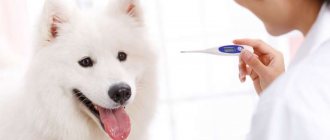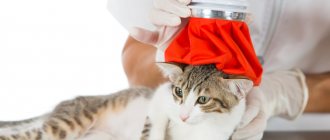Normal temperature in cats
Every cat owner needs to know the normal temperature of their pets. Body temperature in cats, like all animals, may vary slightly within normal limits, depending on the age of the pet, time of day and physical activity. Table of normal temperature values for kittens and adult cats
| Age | Temperature readings |
| Newborn kittens up to 10 days | 34.7 - 37.2 C° |
| Kittens from 10 days to 4 weeks | 36.5 - 37.5 C° |
| Kittens over 4 weeks old and adult cats | Acceptable: 37.5 - 39.5 C° |
| Optimal: 37.7 - 39.3 C° |
Temperatures in the morning may be slightly lower than in the evening. With prolonged exposure to extreme heat, stress and excitement, and even overeating, the body’s natural response is possible in the form of a slight increase in temperature above optimal values, but within acceptable values, which also does not require emergency action.
Which is considered normal?
In this section we will talk about what body temperature in a cat can be considered normal, so as not to force the owner to worry about the health of his pet.
Cat with a thermometer
Body temperature of an adult cat
In fact, for each representative of this species of the animal world, the temperature is set depending on the characteristics of its body, which are manifested under the influence of many external and internal factors. In general, it can vary within 37-39.5°. Moreover, any indicator for an individual cat can be normal, but for another it can be too low or too high. Typically, the body temperature of an adult animal ranges from 38.5-39°.
Important! To prevent a pet's illness from becoming a surprise, owners are advised to regularly measure its weight and temperature.
If the temperature is above 39° and does not subside within two to three hours, this may be a cause for concern and, possibly, a visit to a veterinarian.
Kitten body temperature
Due to the growth of their bodies, kittens have different characteristics from adult cats, including how their body temperature should be perceived differently. A constant change of activity (sleep-play) is determined by the accelerated metabolism of kittens. Therefore, a change in body temperature at such a tender age is a fairly common occurrence.
On average, a kitten’s temperature remains within the range of 38-39.5° and is considered normal. Like almost any warm-blooded creature at a younger age, kittens' temperature normal decreases as they grow older. If the kitten is very small, a low body temperature may be more dangerous than a high one.
Kitty
Attention! If a kitten's temperature rises and does not go away, it is likely that its body has encountered some kind of virus.
It will not be possible to determine the temperature of a kitten by its nose, as in adult cats, because their mucous membrane works somewhat differently. A “jumping” temperature can be explained by playing, eating, or sleeping. If a person keeps a kitten in the house, he should provide it with approximately constant comfortable air temperature.
It’s interesting that if a baby is cold, his body temperature can reach 40° without any special consequences. Usually, upon reaching 15 months, all the physiological rules for maintaining temperature that exist in adult cats become applicable to a kitten.
How to tell if a cat has a fever
Today, the only accurate method to understand that a cat has a temperature is to use a thermometer. However, there are several signs that indicate your cat is not feeling well.
- Lethargic or inappropriate behavior
- Loss of appetite
- Increased thirst
- Rapid or, conversely, infrequent breathing
It is impossible to accurately determine elevated body temperature “by the nose”! Of course, a healthy cat's nose should be cold and damp, but only an active cat under ideal conditions. The humidity of the nose and its local temperature are influenced by the pet's activity, nervous excitement, desire to drink and eat, and environmental climate.
When are temperature changes not dangerous?
Despite the seriousness of the situation, when an animal has an elevated temperature, you should not immediately panic if there are no other health-threatening signals (digestive disorders, fever, unusual behavior, etc.). For example, in the morning the cat’s temperature is lower than in the evening, and during physical activity (after running, playing) the indicators are also higher. A cat that has eaten will have a temperature slightly higher than normal. In such cases, the animal will not look sick or tired. As mentioned above, kittens most often have a temperature that is about 1 degree higher than that of an adult animal. Pregnant cats have a higher temperature than other females. A decrease in temperature can be considered normal if the cat was outside during the cool season, if the room is fresh or there is a draft, that is, a frozen animal will have lower levels. Older cats often have a low body temperature.
How to measure a cat's temperature
So, using a thermometer is the only reliable way to determine body temperature in animals. But which side to approach and how to measure a cat’s temperature?
There are 2 types of thermometers used for animals:
Ear thermometer
- Classic thermometer
- Ear
Classic thermometer
can be alcoholic or electronic. It is used rectally. You can measure a cat's temperature not rectally.
Ear thermometer
a more modern device, its use is less stressful.
How to take a cat's temperature rectally
- Have a helper help hold and calm your cat during the procedure. During temperature measurement, most pets behave calmly, but particularly temperamental cats may resist. It is better to entrust such animals to a veterinarian. An aggressive cat can cause harm to itself or its owner.
- Prepare a thermometer. It is better to use a veterinary or children's electronic thermometer. Measuring temperature with such a device is more comfortable and takes only 2-3 minutes.
- Wipe the tip with alcohol and lubricate it with Vaseline or Levomikol ointment.
- Raise your tail. Slowly, using a twisting motion, insert the thermometer into the anus to a depth of 2-3 cm. Hold the thermometer until the beep sounds.
- After the signal, do not rush to remove the thermometer. Make sure that the device works correctly and the numbers do not increase. On some models, the signal is triggered ahead of schedule and for an accurate result you need to hold the device in the rectum for another 20-40 seconds.
- Evaluate the measurement result and wipe the tip of the thermometer generously with an alcohol wipe.
How to Measure Temperature with an Ear Thermometer
- Calm the cat down. Let the thermometer sniff, show your pet that the device does not pose a danger. When measuring ear temperature, you can usually do without an assistant.
- Wipe the tip of the thermometer with an alcohol wipe.
- While supporting your pet's head, insert the thermometer into the ear canal. Most cats are indifferent to the procedure. Do not try to push the thermometer very deep, so as not to damage the eardrum.
- Wait for the beep and make sure the readings do not increase.
- Remove the thermometer from your ear and compare the result with the norm.
- Disinfect the thermometer tip again.
Temperature in dogs and cats
October 7, 2013
What should be the temperature of dogs and cats, how to measure it correctly and what to do if the animal’s temperature is elevated or decreased, says Ekaterina Anatolyevna Chubarova, veterinarian, head of the rehabilitation department of the Biocontrol clinic.
— What does temperature mean as an indicator of an animal’s health?
— Temperature, both for humans and animals, is a fairly important indicator of well-being.
— What is the normal body temperature of cats and dogs?
— Temperature standards are generally accepted and have upper and lower limits. For cats the norm is 38.0 - 39.5, for dogs 38.5 - 39.0. Of course, in young or dwarf animals these boundaries may be shifted (upward) against the background of active metabolic processes in the body. It is worth mentioning that the upper limit is also considered the norm, but an increase of 0.1 may be an alarming indicator.
— What does a decrease in temperature mean?
— A decrease in temperature (hypothermia) can be of a different nature. The appearance of hypothermia, of course, is often associated with an external factor - prolonged exposure of the animal to the cold. Internal causes may be a state of shock, a hormonal disorder, diabetes mellitus and a number of others. If we consider external factors of influence, then it is worth considering that young animals and very small ones become hypothermic very quickly.
— How can we help an animal in this condition?
- Cover with a warm blanket and put on a heating pad. And the very first aid is the introduction of warm solutions.
— When can we say that a pet’s temperature is elevated?
— If an animal’s temperature is elevated, that is, you measured it and it is above the upper normal limits, and not just “hot ears, nose, paws,” then we can talk about such a phenomenon as hyperthermia. The reasons for the increase in temperature can be different: stress, a long trip to the clinic, hot weather, prolonged exposure to the sun, rich fur. And, of course, an inflammatory or infectious process.
— What first aid can the owner provide in case of hyperthermia?
“First of all, it is necessary to cool the animal as quickly as possible. Cover it with ice, turn on the air conditioner or open a window, and remove the bedding from under it. If you are far from the clinic or doctor, and the temperature remains high after some attempts, then you can try doing cooling enemas with cold solutions. But it is still better, if possible, to consult with a doctor by phone, as he will be able to prescribe antipyretic drugs before going to the clinic.
— How to measure an animal’s temperature?
- Many owners believe that this can be done in the same way as in humans - by placing a thermometer in the armpit. However, among our smaller brothers, the temperature is measured rectally (through the rectum) and only with an electronic thermometer. Position the animal comfortably, ensuring fixation (relative immobility of the animal). Then lubricate the tip of the thermometer with Vaseline or hypoallergenic cream. Move the animal's tail to the side and insert the tip of the thermometer into the anus to a depth of 1.5-2 cm with a smooth movement. Wait a few seconds for the sound signal and then remove the thermometer with a smooth movement.
— How many times does it take to measure an animal’s temperature for an accurate result?
— Ideally, all measurements - temperature, pressure, heart rate and other indicators are best measured several times and choose the average value. But, if the owner’s task is to determine by temperature whether it is necessary to see a doctor or whether there is no reason to worry, then once is enough. Temperature is an individual indicator, and a slight increase or decrease is not always a warning sign. There is no need to measure your temperature daily or several times a day. In normal life, an animal is measured only at a doctor’s appointment or during a controlled mating of animals.
— How to ensure disinfection of a thermometer?
— Your animal should have its own thermometer, and in no case should it be shared with family members! Before and after use, you should wipe the tip of the thermometer with an alcohol swab, alcohol solutions, or wash with soap.
— How do I know if I did everything correctly when measuring my pet’s temperature?
— If the animal does not experience too much discomfort from the insertion of the thermometer, there is no deterioration in the condition and the temperature is within the expected figures (at least 30 degrees, which may indicate a malfunction of the device itself), then we did everything right. The animal must be at rest before taking the temperature. In this case, the animal must be in the room for more than thirty minutes, and not just returned from a walk.
— Is an increase or decrease in an animal’s body temperature a sign that it is sick?
— Temperature is not an independent sign of illness. Quite often, the temperature may be within the normal range, but other symptoms create the clinical picture of the disease. If your pet has a fever combined with other symptoms - refusal to feed, lethargy, impaired diuresis, vomiting, then in such cases, of course, you need to consult a doctor.”
We also recommend reading:
- When do cats and dogs really have a fever? Article by Professor Mitin
Tatyana (10/11/2014 at 15:48): The dog got sick
Reply | to write a message
Nastya (02/12/2015 at 01:15): Hello! My dog (Jagdterrier) has pain in his back leg, at first there was redness on the central pad, then it went between the toes and became swollen. We thought it was from the reagents, we read on the Internet what to do. We smeared levomekol, soaked the paw in a chamomile decoction and it seemed to begin to heal, the swelling and redness subsided, we stopped constantly bandaging and our dog started gnawing his paw, we started bandaging again, so she chewed the bandage, chewed all the skin until it bled, and again all over again - everything is swollen, red, and now she is limping, trying not to step on this paw. In the meantime, they were giving her a lotion, and they kept the bandage on her muzzle by force, so she was eager to chew on the wound. and now she doesn’t eat anything, her stomach is very seething, but there are no loose stools. I gave her a chamomile decoction again. Now I’m thinking, maybe this is an infection? Maybe you can say something, suggest something. We live far from you and I don’t have a car, and calling a doctor at home...is expensive for me. Of course, I want the doctor to examine my dog, but maybe you can at least suggest something first. Thank you very much in advance anyway.
Reply | to write a message
- Biocontrol (04/02/2015 at 10:40): Nastya, unfortunately, for technical reasons we were not able to promptly answer your question. We hope that everything is fine with the dog now, but for the future, you should never treat anyone yourself by reading the Internet. Only a specialist can make a diagnosis and prescribe the correct treatment.
Reply | to write a message
Alena (09/30/2020 at 05:01): Hello, my dog gave birth, on the 3rd day after birth she pulled out 2 ticks, she doesn’t eat anything, is lethargic, well, not at all. I took the temperature of 39.5. Help, tell me what to do?? ?
Reply | to write a message
- Biocontrol (09/30/2020 at 09:29): Alena, hello! The dog needs to be taken to a veterinarian immediately.
Reply | to write a message
Click to cancel reply.
My cat has a high fever, what should I do?
If you find that your cat has a fever, don't panic. An increase in body temperature occurs with infections, infection with worms, non-infectious inflammatory processes in organs, allergic reactions and some surgical diseases.
Elevated temperature (hyperthermia) is a signal of the presence of pathology, so first of all you need to determine the severity of the process.
Severity of hyperthermia
| Temperature | Severity | Owner actions |
| 39.5 - 40.0 C° | Lightweight | 1. Do not administer antipyretics from a human first aid kit. Many drugs used for humans are toxic to cats! 2. Use physical cooling methods. Use ice and provide your cat with plenty of fluids. |
| 40.1 - 40.5 C° | Average | 1. Diagnostics required! Call the veterinary clinic immediately and tell the receptionist that your cat has a high fever. You will be advised on what medications can be used to bring down the temperature and will definitely schedule an appointment as soon as possible. 2. Use physical cooling methods, provide the cat with water and rest. |
| >= 40.6 C° | Heavy | Emergency condition . Temperatures above 41.0 are life-threatening! The pet requires an urgent appointment with a doctor, placement of the cat in a hospital, intensive care and IV drips to restore salt balance. |
Be careful with kittens. Children have weak immunity and are highly susceptible to viral diseases. Even a slight increase in temperature is dangerous to health and delay in proper treatment can lead to death!
Normal body temperature
The body temperature of a cat, provided that it is an adult and healthy animal, can vary from 38 to 39.5 degrees. This is an individual indicator of the body, which is determined by certain features of the functioning of the hypothalamic-pituitary and the entire central nervous system of the animal and depends little on the influence of external factors.
Every owner must periodically take their pet to the veterinarian for a medical examination, during which the temperature must also be measured. It is necessary to understand what this indicator is normally in a cat. After all, if she shows signs of deviations, then after measuring the temperature it will need to be compared with the baseline indicator.
If it is normal for an animal to have values around 39 degrees, then an increase of two tenths will not be a sign of pathology.
In other words, a cat’s usual temperature is about 38 degrees, then a value of 39.2 will already indicate some serious process.
By the way, it is worth considering that for sphinxes the normal temperature is 41.5 degrees.
Body temperature in cats depends on many factors. The most significant of them are:
- age (in older cats, the indicators gradually decrease, which is due to a general slowdown of all processes in the body);
- gender (as a rule, male animals normally have higher temperature readings, since they have a faster metabolism, they are more active and stronger);
- physiology (when a cat lies down, sleeps, its temperature drops quite significantly, since all processes slow down due to the lack of need to produce energy; after eating, a period of high activity, the temperature rises);
- time of day (in the morning the indicators are lower than in the evening);
- health status (if a pathological process occurs in the animal’s body, this may affect the functioning of the thermoregulation mechanism).
Low temperature in a cat
Low temperatures in cats are less common than high temperatures. This condition is called hypothermia. It is typical for hypothermia, shock, the post-anesthesia period and sometimes the oncological process.
- It should be kept in mind that it is completely normal for pregnant cats to drop their temperature by 1 degree one to two days before giving birth.
- Temperatures below 36 degrees are life-threatening!
Put the cat on a heating pad and wrap it in a warm blanket. Offer your cat a warm drink or low-fat broth. Call the veterinary clinic. Depending on the severity of the process, IVs and intensive care may be required.
Why does a cat's body temperature rise?
There are several reasons why a cat's body temperature rises:
- Overheat. Especially if it’s hot outside, an increase in body temperature is a protective reaction of the body. This is how the pet regulates its heat exchange and releases “excess” into the environment. So make sure that the cat is not outside in the heat without the opportunity to hide in the shade and drink clean, cool water. Well, keep an eye on the room temperature. Cats often overheat at home.
- After physical activity, eating food, and also during pregnancy. That is, the pet is absolutely healthy, there is no reason to worry. The rise in temperature will be insignificant (no more than a degree, and is called low-grade fever), and the mustache itself will behave as usual: cheerful, with a good appetite.
- Inflammatory process in the body. Fever during inflammation is the main symptom. Therefore, if you do not notice any external changes in your pet, but the temperature has risen, immediately seek help from a veterinarian. It is especially dangerous when the fever is accompanied by a cough, runny nose, frequent or, conversely, rare breathing, vomiting or diarrhea. Often this indicates an infectious disease or a serious inflammatory process.
Increase in temperature after sterilization, vaccination
If there is a fever after surgery, this is not always a reaction to surgery. Yes, on the first day the cat’s temperature after sterilization may increase slightly. After all, this is a “shock” for the body, it is trying to recover and protect itself. But if a number above 40 degrees appears on the thermometer, the cat becomes lethargic, apathetic, refuses food and water, constantly lies down or hides, then immediately contact a veterinary clinic or call a veterinarian at home. This condition may indicate the onset of inflammation, and antibiotic therapy may be required.
After vaccinations, a jump in temperature may also be recorded. If it is small (about 1 degree above the upper limit of the physiological norm), then do not panic. This is absolutely normal. The immune system began to work, to fight the pathogens received with the vaccine. A slight fever can last up to 3 days. however, if the temperature is too high, then it is better to contact a veterinarian to exclude (or confirm) a mustache disease and begin treatment on time.
Temperature of cats and dogs
How is temperature determined in dogs and cats?
Thermometry can be carried out by the animal owner himself, before visiting a veterinarian. To measure body temperature in animals, use a regular medical thermometer. Thermometry in animals is performed with precautions. Dogs and cats are placed on a table or floor and held tightly. Body temperature in animals is determined in the rectum. The thermometer is shaken, lubricated with Vaseline or oil and inserted with care, with rotational movements, into the rectum. The thermometer is attached to the tail using a cord or thermometer holder. After 10-15 minutes, the thermometer is removed and the animal’s body temperature is determined.
What is the normal temperature for dogs and cats?
The body temperature of an animal does not greatly depend on the ambient temperature, but is directly dependent on the formation of heat in the body. Heat in the body is formed as a result of chemical reactions during the decomposition of food entering the animal's body. The body retains part of the generated heat to maintain body temperature, the rest of the heat is removed from the body. The heat remaining in the body is the guarantor of temperature constancy for each animal species (Table 1).
| Kind of animal | Index | Kind of animal | Index |
| Horses | 37,5 – 38,5° | Cats | 38,0 — 39,5° |
| Donkeys | 37,5 -38,5° | Rabbits | 38,5 -39,5° |
| Mules | 38,8 -39,0° | Guinea pigs | 37,8 -38,5° |
| Cattle | 37,5 – 39,5° | Chickens | 40,5 — 42,0° |
| Sheep | 38,0 —40,0° | Geese | 40,0 — 41,0° |
| Goats | 38,0 — 40,5° | Ducks | 41,0 -43,0° |
| Camels | 35, 0 — 38,6° | Turkeys | 40,0 — 41,5° |
| Deer | 38,0 — 38,6° | Pigeons | 41,0 — 43,0° |
| Pigs | 38,0 – 40,0° | Pheasants | 41,0 — 44,0° |
| Dogs | 37,.5 — 39,0° |
Limit of fluctuations in animal body temperature Table 1
It should be borne in mind that the body temperature of healthy animals is subject to fluctuations depending on a number of factors.
What factors influence the body temperature of animals?
Owners of dogs and cats should be aware of these factors so that at some point they do not mistakenly assume that your pet is sick. The temperature of young animals, especially in the first week of life, is higher than that of older young animals.
Temperature in pregnant women
animals in the last weeks of pregnancy increases (by 0.5 - 0.7 °) and 12 - 50 hours before birth decreases (by 0.4 -0.8 °).
The body temperature of females is slightly higher than that of males and castrates.
The external environment has a great influence on the body temperature of animals. The temperature of a dog exposed to the sun for a long time increased by 2.5°. The temperature in dogs in winter is 0.1 -0.2° higher than in summer. Keeping dogs in stuffy, poorly ventilated areas increases body temperature by 1.0 – 1.8°C. With large muscular movements, a large amount of heat is generated in the animal’s body, which cannot be removed from the body in a short time and, as a result, the body temperature rises. The pet owner needs to take these factors into account. Do not sound the alarm about a sharp rise in temperature after heavy muscle activity. Give the animal a rest for 30 - 60 minutes and the temperature will return to normal limits. It was observed that when cold food or water was given, the dogs' body temperature dropped by 1°C and returned to normal levels within 5–6 hours.
In addition to the above factorial increases in body temperature, temperature increases in animals and humans are observed as a general response of the body to the influence of a harmful, often infectious, agent. This reaction is medically called fever (febris ) .
Almost all infectious diseases of dogs and cats are accompanied by fever.
What are the reasons for this increase in body temperature?
Such an increase in body temperature or fever
may occur under the influence of various reasons. Substances that cause it are called pyrogenic (pir - heat). These substances include microbial bodies and their toxins, breakdown products of proteins, tissue, leukocytes, as well as a number of other substances of internal and external origin. There are two types of fevers: infectious, when the cause of an increase in body temperature is a microbe or its poison, and non-infectious (protein, salt, drug and neurogenic).
Protein fever
can occur when animals are given protein drugs, or when a large amount of proteins accumulates in the body (with hemorrhages, hemolysis, malignant tumors).
Salt fever
occurs when hypertonic solutions of sodium chloride are administered to animals for therapeutic purposes.
Drug fever
may occur with the introduction of large doses of certain drugs (nicotine, caffeine, adrenaline, thyroxine, certain antibiotics).
Neurogenic fever
occurs with trauma to the central nervous system, tumors and hemorrhages in the brain.
What are the signs of fever?
The main symptom of any fever is, of course, high body temperature due to a disorder of thermoregulation. In addition, it is necessary to note the presence of chills , which is accompanied by trembling of individual muscles ,
and with severe chills and trembling of the whole body.
Cooling of the skin, ruffled fur and loss of shine in the coat are also observed .
At the onset of fever, appetite decreases, and then food refusal occurs, and the function of the stomach and intestines is disrupted.
Disorders of the cardiovascular system include increased heart rate, increased heartbeat and sounds with subsequent weakening, a drop in blood pressure, and congestion.
Disorders of the nervous system are characterized by lethargy, varying degrees of depression and fibrillary muscle twitching.
How to bring down a high temperature?
The question is interesting and before answering it it is necessary to answer another question - what is the significance of fever for the body? Scientists have three answers to this question. The first answer is fever and especially high temperature is a protective reaction of the body and it plays a healing role for the body. Experiments have established that if during an infectious disease in humans and animals, in the presence of deep general lesions of the body, there is an absence of high temperature, which is a bad diagnostic sign.
The second answer is that all disorders that are observed during fever arise due to the presence of high body temperature of the patient and for each febrile state it is necessary to widely use antipyretic drugs.
The third and correct answer is fever, with a moderate increase in body temperature; this is an adaptive reaction of the body during infectious diseases and is a beneficial phenomenon for the body..
Excessively high temperatures can provoke further metabolic disorders, in which case the use of means to reduce body temperature may be useful.
So, what is the answer to your question – what to do with high temperatures? In this situation, it is necessary to urgently contact a veterinarian and he will determine the underlying disease that caused the increase in temperature and fever, outline therapeutic measures for the underlying disease and may decide to use drugs that lower the high body temperature of the sick animal.
Why does my dog have a low temperature?
This phenomenon is less common than high temperatures. A decrease in body temperature by 1° compared to normal is called subnormal temperature. When assessing a low temperature, you must take precautions and check whether the thermometer is working properly. A sharp drop in temperature by 3° or even 4° can occur with collapse, which is characterized by cooling of the entire surface of the body, decline in cardiac activity, and general weakness. The pulse is frequent, barely perceptible. Persistent subnormal ones are observed in old, emaciated dogs and cats, as well as after severe blood loss and in chronic brain diseases (dropsy, tumor).
Temperature of cats and dogs
Animal body temperature (measuring body temperature in dogs and cats)
Body temperature is the balance between the production of energy generated as a result of the body’s vital activity and its release into the environment. Constancy of an animal's body temperature is a necessary condition for metabolism and the leading factor ensuring the normal level of tissue processes in the body. At the same time, the level of metabolism and energy determines the constancy of the animal’s temperature. The maintenance of thermal homeostasis (equilibrium) in the body of animals is carried out thanks to the activity of a complex physiological mechanism that regulates heat production and heat transfer. Heat production is a chemical process, and heat transfer is a physical process.
Based on body temperature, animals are divided into two large groups. One group includes the so-called poikilothermic (cold-blooded) animals . Their body temperature changes passively following fluctuations in the temperature of the external environment. These include reptiles, amphibians, insects, etc. Another group consists of homeothermic (warm-blooded) animals - birds and mammals. They are able to maintain a stable temperature of the internal organs of the body at a certain level. This constancy of body temperature is called isothermia . Each species of homeothermic animal is characterized by a certain temperature limit . If the body temperature of different species of animals is relatively constant, then the temperature of the body surface (skin) is subject to significant fluctuations. This depends both on the amount of heating of the skin by the flowing blood, and on the cooling of it by the environment. Therefore, the body of warm-blooded animals is divided into two parts: the internal, or core (internal organs, skeletal muscles), and the superficial shell of the body (skin, limbs). Approximately 50-60% of the chemical energy of the feed released in the body is converted into chemical bonds. The rest of the energy during these transformations is released in the form of heat, which is dissipated in the tissues and heats them. Temperature homeostasis is mainly maintained by the core of the body. The constancy of an animal’s body temperature, on the one hand, is achieved by chemical thermoregulation, and on the other, by physical thermoregulation.
Chemical thermoregulation. Chemical thermoregulation includes a set of physiological processes that ensure metabolism and heat formation in the body of animals when exposed to various temperatures and other environmental factors. As is known, heat is generated during oxidative processes in cell mitochondria. Muscles and glands, making up the majority of living tissues, serve as the main sites of heat production. More than 80% of body heat is generated in skeletal muscles during work. The second place in heat production is occupied by the liver. Therefore, the leading role in the implementation of chemical thermoregulation belongs to skeletal muscles and the liver. Metabolism and energy are affected by ambient temperature. When the external temperature decreases, the metabolism increases, and, conversely, when it increases, it decreases in order to prevent the body from overheating.
Physical thermoregulation. Physical thermoregulation is understood as a set of physiological processes that regulate the release of heat from the body and thereby ensure the constancy of the animal’s body temperature.
The body removes heat energy in the following ways:
- by radiation, that is, the transfer of heat by radiation through invisible infrared radiation from the surface of the body. The higher the body surface temperature, the more intense it is.
- During evaporation, thermal energy is lost, because When water transitions from liquid to vapor, heat is removed from the surface from which evaporation occurs.
- with feces and urine.
It is important that the skin plays an important role in thermoregulation , since about 60% of the total heat loss during evaporation occurs through it. Sweat glands contribute to this. Depending on the level of chemical thermoregulation, the performance of muscular work and the ambient temperature, different amounts of sweat are released. For example, cats and dogs do not have a mechanism for producing sweat for cooling through evaporation; due to the poor development of sweat glands, little heat loss occurs through the sweat glands that are present on the crumbs of the paws.
Regulation of body temperature. The main center that regulates an animal's body temperature is the hypothalamus . In its front part there is a heat transfer center, and in the rear part there is a heat generation center. Due to the presence of thermal and cold receptors in the skin, signals about temperature changes are sent to the thermoregulation center, which transmits corresponding impulses to the vascular, respiratory, motor and other centers involved in thermoregulation. As for changes in body temperature, its increase (hyperthermia) is often not only a protective mechanism of the body (a reaction to the introduction of foreign agents (viruses, bacteria, protozoa)), but also a sign of an inflammatory process. So, during the summer heat, pets can easily be at risk of heatstroke - this is a critical condition of the animal that occurs as a result of overheating of the body. Heatstroke can occur in hot, muggy weather when the body is unable to release excess heat to the environment, and the balance between body heat production and dissipation is disrupted.
Also, the reasons for the increase in temperature may be:
- eruption of molars;
- vaccination (vaccination);
- stress;
- a wound, or rather an abscess after advanced skin damage;
- joint inflammation;
- allergy;
- infections;
- and so on..
You also need to know that:
- in young animals the temperature is 0.5˚C higher than in adults.
- emaciated animals have a lower temperature than well-fed ones
- Females have a higher temperature than males
- the temperature rises by 1-1.5˚C and remains this way for 3-4 hours after eating the food.
- a significant increase in temperature is also observed after prolonged muscle movements.
A decrease in body temperature in cats and dogs (hypothermia) below the physiological norm is a threatening sign. Often the temperature drops in weakened kittens and puppies due to viral diseases in which immunosuppression occurs (immune suppression). Reduced temperature in cats and dogs in old age can be observed with chronic kidney and/or liver diseases and may not manifest itself symptomatically. The physiological norm is a decrease in temperature in females during the prenatal period (about a day before birth, the temperature decreases by 1 degree). When keeping animals in cold rooms or outdoors, at negative air temperatures, a decrease in body temperature also occurs due to too high heat transfer in cold conditions (especially in small dogs). The temperature decreases with polytrauma (multiple injuries), bleeding, and also during anesthesia. Low temperature in dogs and cats is accompanied by symptoms such as weakness, bradycardia (slow heart rate), rare shallow breathing, hypotension (low blood pressure), slowed intestinal motility, and decreased diuresis. In general, in such cases, veterinarians talk about the animal’s body being in shock.
Actions in case of deviation from the norm
An attentive owner will always understand that something wrong is happening to the cat: external signs that differ in hyper- and hypothermia will tell him about it.
At reduced temperatures the following are noted:
- bradycardia;
- decreased activity and lethargy;
- hypotension;
- blanching of mucous membranes;
- slow breathing, sharp inhalation/exhalation.
- trying to find a warm place.
At elevated temperatures the following are observed:
- tachycardia;
- chills and fever;
- loss of appetite and refusal to drink water;
- drowsiness and apathy;
- dehydration (with prolonged fever);
- diarrhea and/or vomiting with a bad smell (in severe cases).
In general, you should be wary of any deviations from the temperature norm, as they can signal various diseases, sometimes very serious ones.
If the elevated temperature
An increase in temperature can be caused by both diseases and other (non-physiological factors):
- viral diseases - cats usually have distemper (panleukopenia), calicivirus, rhinotracheitis and coronavirus;
- inflammatory processes - often occur when wounds or postoperative sutures become infected;
- overheating - kittens, old and weakened cats that are forced to stay in the heat for a long time, for example, in a car or in a stuffy room, often suffer from it;
- stress often provokes a failure of thermoregulation. The reasons may be a trip in transport, a visit to the veterinarian, a change of owner or place of residence.
This is interesting! The temperature often rises by about 1 degree after vaccination, when the body produces antibodies against viruses, or sterilization (as a reaction to surgery).
Actions at elevated temperatures
If going to the vet is not possible, use the following methods to reduce the fever:
- humidify the air in the room;
- give the cat cool water (if it refuses, drink it from a syringe without a needle or pipette);
- moisten exposed skin with water;
- wrap in a wet towel;
- Place ice behind your ears, neck, or inner thighs.
Self-treatment, especially with the use of drugs developed for the human body, is not allowed. Antibiotics and antipyretics can negatively affect the cat’s body, causing allergies or liver/kidney problems.
If the low temperature
The reasons for a drop in temperature in a cat are internal pathologies and external factors, such as:
- exhaustion and loss of strength caused by chronic malnutrition;
- viral infections (against the background of weakened immunity);
- dysfunction of internal organs (heart and blood vessels, endocrine system, liver and kidneys);
- blood loss that occurs after injuries and operations (internal bleeding is especially dangerous, which the owners do not notice immediately):
- helminthiasis – infection with parasites leads to exhaustion, anemia and impaired thermoregulation.
But the most common cause of a drop in temperature is hypothermia, which occurs after a cat has been in the cold for a long time.
Actions at low temperatures
If hypothermia is caused by hypothermia, your pet needs to be warmed up quickly:
- wrap in a blanket/plaid;
- place in a warm, wind-free place;
- give warm liquid to drink (you can use a pipette);
- Cover with heating pads or hot water bottles.
If your efforts are ineffective, take the cat to the hospital. There, most likely, she will be given a warm enema and put on a drip with saline solution.
We recommend reading: What to Know About a Dog's Temperature











